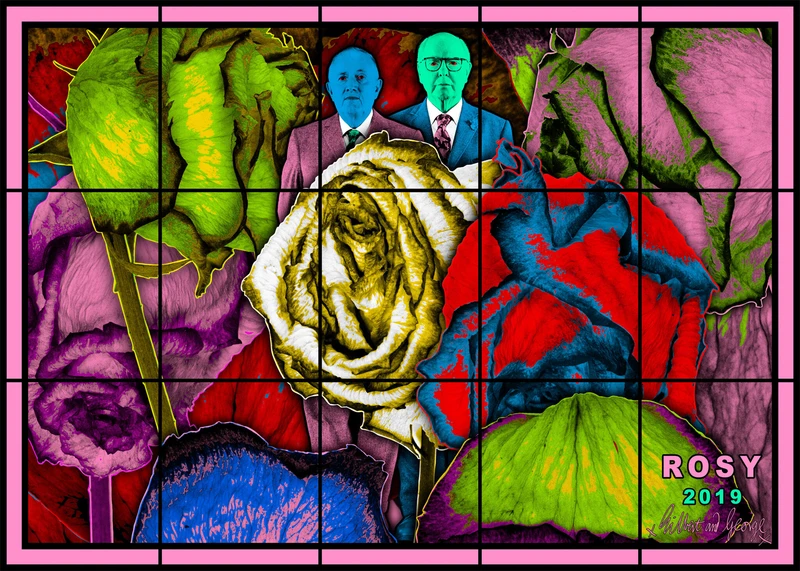PARADISICAL PICTURES
1 Apr 2023-11 Feb 2024


Two men like the ghosts of old-style vaudevillians, dressed in varicoloured matching suits with collar and tie, pose in dead-eyed attitudes of shock and exhaustion within a violently coloured jungle world of monstrous decaying blossoms and vegetation. Their expressions are vacant, locked in dream-state. Here they dance a zombie-dance; there they gaze transfixed, empty-headed, or confronted deep within themselves by some new vision.
Then these men stare up at us with red demonic eyes. It looks as though they are drowning in a whirlpool of dead flowers; they become body shapes made of chain, their faces appear on date stones; and here they stand before us, in a formal pose, straight-backed, like other-worldly librarians, middle-managers of the dead, returning our gaze. They are stern and severe.
They look as though they are regarding us from another dimension. In their suits and ties – uniforms of respectable responsibility – they stand surrounded by giant flowers, by roses and their thorny stems, the petals of which are fleshy and wilting in sickly toxic shades of acid green, dusty pink, puce, scarlet, mauve.
Such is the world of the thirty five PARADISICAL PICTURES made by Gilbert & George in 2019. It is a world in which atmosphere doubles as event – a quality shared with the films of Alfred Hitchcock or early animated films by Walt Disney studios. Their heightened, saturated, violent, cloying colours convey hallucinogenic portent, unease – like musty-sweet sleeping gas.
Gilbert & George take their place in this disquieting vision of a heavenly place in a manner resembling psychical reports or transmissions from a journey deep into an enchanted forest or overgrown park. It is a psychedelic landscape, as though the pre-Raphaelite artists of the mid-nineteenth century, more given to poetic realism and Arthurian legend, had secretly envisioned science-fiction. The disembodied eyes of Gilbert & George stare unnervingly through tangles of fluorescent briars, reminiscent of the effigies of Green Men nature spirits superstitiously admitted into the decoration of churches by medieval stone masons.
This particular paradise – paradise being the common goal of spiritual and secular life on Earth – inhabited or traversed by Gilbert & George, is a place where the very air is drugged. From picture to picture the artists are subject to biomorphic alteration into vegetable states – a turn of events that would be cartoon-like and absurd were it not so equally sinister. The dead yet watchful eyes of Gilbert & George stare sleeplessly from grotesque detritus of fruits and flowers; from masks of dead leaves – details of spirit faces, as the artists themselves are seen first pursued by unseen wonders or horrors, then finally exhausted, worn out, in a sleep that seems to promise no rest.
The longer you look at these PARADISICAL PICTURES, the more they suggest a chapter in a story that has been unfolding before them and will continue beyond them. This ‘paradise’ is not a destination but a stage on a longer journey. It is a dream of paradise – the exploration of an archetype; to be granted bliss, eternal rest, true life, revelation, the answer to life’s mysteries. The paradise of these PARADISICAL PICTURES, however, proposes a more ambivalent view – a place of mutation, exhaustion, watchfulness and possession: an empty promise. The viewer must decide.
But the paradise explored in the PARADISICAL PICTURES is historically linked to the earlier stages on the visionary journey of Gilbert & George. In the charcoal-on-paper sculptures of the early 1970s, such as “THERE WERE TWO YOUNG MEN” or “THE GENERAL JUNGLE”, the viewer sees Gilbert & George when they were young men, surrounded by nature – conversing, walking, relaxing. The countryside appears gentler, more mannered – a prelapsarian state of youth. Nearly fifty years later, the jungle garden seems darker and stranger, the travellers close to exhaustion…
The art of Gilbert & George confounds and rejects all art historical classification or affiliation to other schools or movements in art. As evidenced by these PARADISICAL PICTURES there is no formalist, aesthetic or conceptual precedent to the ideology and vision they convey with such intensity. They are fantastical, allegorical, narrative, representational, psychedelic, absurdist, modern yet archaic, surrealist-grotesque, inflected with both tragedy and comedy, filled with pathos, touchingly eloquent of human frailty, age and exhaustion. They suggest a philosophy but do not dictate its tenets. In short, the art of Gilbert & George is a visionary art, above all – reports from a long journey through life, emotional, spiritual, psychical, cosmic, that begins on the streets of London…
Michael Bracewell – Trustee, The Gilbert & George Centre